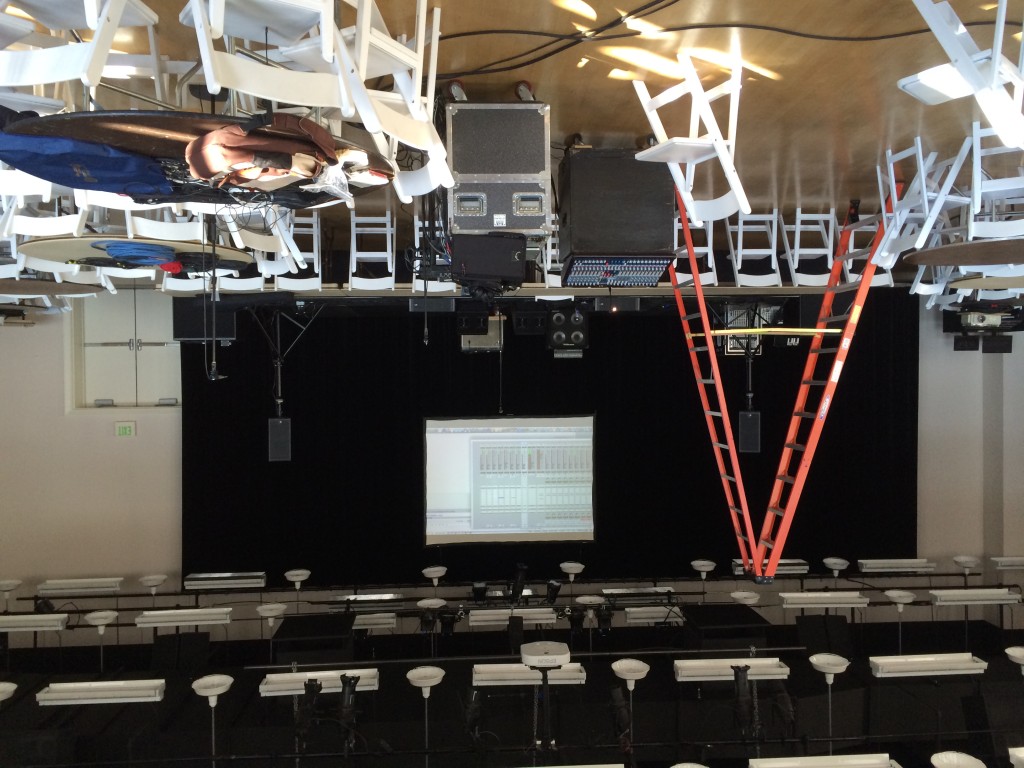After taking Buford Jones (2) day Mixing Workshop, I was inspired to schedule the first Sound 101 workshop for local stage hands who had previously shown interest. About 15 people turned out today. A diverse group of people (some with no past audio experience) with some very perceptive questions. I was actually amazed that some of the most logical questions were asked immediately as information was presented. We discussed acoustics, phantom speakers, time delaying a PA, stitching speaker sub systems together to act as one sonic image, filtering to make a PA work without too much overlap. I guess really, these aren’t “101” concepts at all. How do you EQ a system? Channel? If the PA isn’t aimed correctly? How do you manage your mix if the subs are 15dB too loud in general?
Understanding the nuts and bolts of acoustics and physics obviously has it’s place but I might of done better to show them how to put a simple PA together and use the mixing board. Maybe system design, tuning, etc… should wait. What do you think?
Fortunately there was enough interest after the class to do a follow up workshop tomorrow and try to cover Equalization.
It’s amazing how fast the clock moves when you’re trying to explain things to a group of people.
Using house gear we setup the following speakers:
(2) Meyer Sound UPJ for mains L/R
(2) Meyer Sound 650R2 for subs L/R
(2) Meyer Sound M1D for front fills L/R
(2) Meyer Sound UM1P for stage monitors
We set up the equivalent of (4) PA systems all tied together to make it possible to control signals from multiple locations and with multiple levels of functionality.
The first PA consisted of a single Mackie SRM150 which has a build in mixer, amp and speaker with a master volume and 3 band fixed EQ. One SM58 and a 1/8″ TRS cables to dual RCA for Iphone use. That system was completely self contained to demonstrate how simple a PA might be and how simple it would be to put together and use.
The second PA consisted of an API-3124m mic preamp / mixer. It has (4) inputs, a stereo output, a stereo return and an aux send.
Channel 1 – Wired SM58 @ Stage
Channel 2 – Wireless Sennheiser handheld mic
Channel 3 – Tascam CD L
Channel 4 – Tascam CD R
The outputs of that console landed on a Midas Venice 240 right behind it.
The same wired SM58 and wireless mic also landed direction on the Midas Venice 240 (via passive splitters) so that one system could be completely independent of the other
The same wired SM58 and wireless mic also landed on the house Soundcraft Vi6 digital console @ the true FOH position.
The PA was processed via a Metric Halo 2882+DSP.
Input 1 – FOH measurement mic
Input 2 – Roaming measurement mic
Input 3 – Midas Venice 240 Main output R
Input 4 – Midas Venice 240 Main R output
Input 5 – Midas Venice 240 Monitor 1 output
Input 6 – Midas Venice 240 Monitor 2 output
Input 7 – Loop (from output 8 – for measurement SOURCE purposes)
Output 1 – UPJ HL main
Output 2 – UPJ HR main
Output 3 – 650 Sub L
Output 4 – 640 Sub R
Output 5 – M1D HL front fill
Output 6 – M1D HR front fill
Output 7 –
Output 8 – Loop (right back into Input 8 – for measurement purposes)
Here is a shot of the setup we used.
We also setup a Gallien Kruger RM800 bass amp / Hartke 410XL bass rig and Fender Twin Reverb as sources which we didn’t get to today. Maybe tomorrow.


